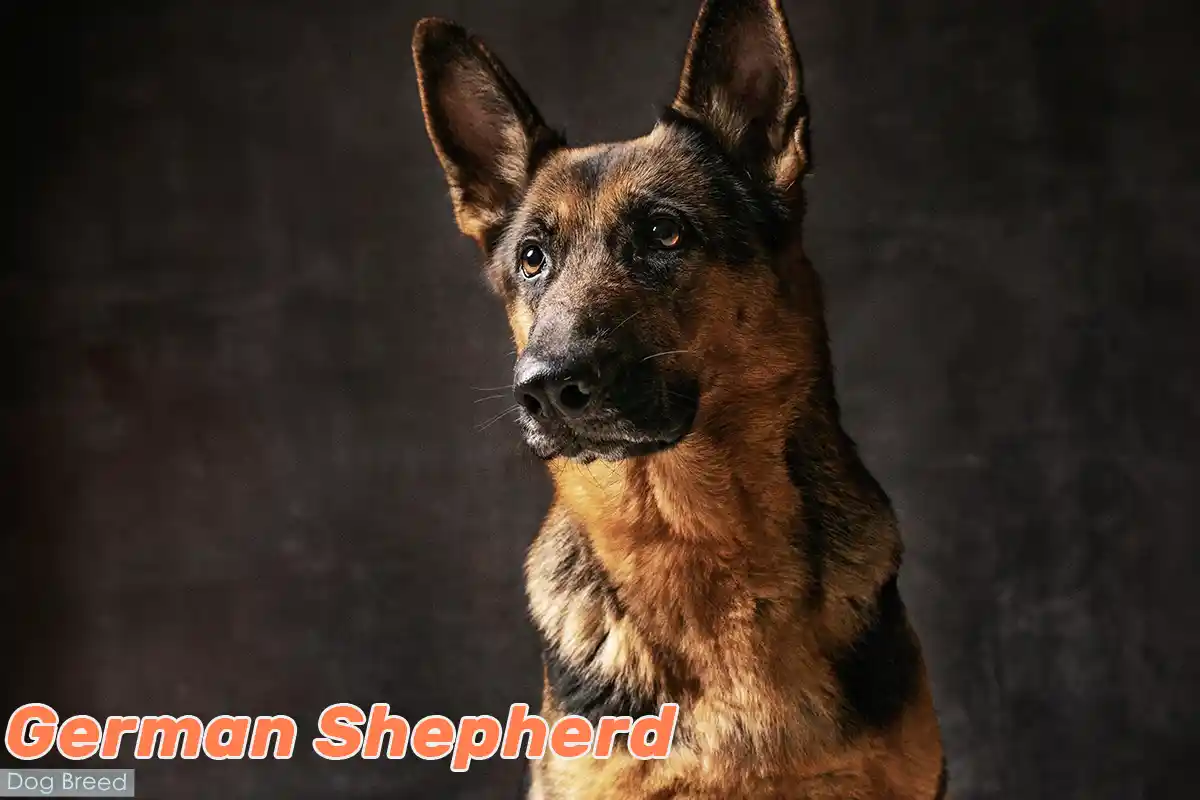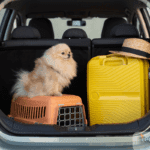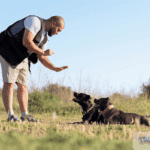German Shepherd Dogs, renowned for their intelligence, loyalty, and versatility, have captured the hearts of millions as America’s second most popular breed. Whether serving as vigilant guardians, dependable working dogs, or loving family companions, German Shepherds bring unmatched dedication to every role.
This breed’s athletic build, alert temperament, and unwavering bond with their families make them ideal for those seeking a steadfast and adaptable companion. However, their high energy levels and strong protective instincts require committed training and consistent exercise.
“We see German Shepherds thrive when they’re provided with structured activities and preventative care,” says Dr. Esther Knoetze, BSc, BVSc. “Their predisposition to hip dysplasia and degenerative myelopathy highlights the importance of regular checkups, joint support, and an active lifestyle.”
Whether patrolling a property, excelling in agility competitions, or cuddling with their favorite humans, German Shepherds embody the perfect balance of purpose, protection, and affection.
Quick Facts: German Shephard
Here’s a snapshot of the German Shepherd Dog’s traits to help you better understand their extraordinary qualities:
| Characteristic | Description | Rating |
|---|---|---|
| Size | Males: 24–26 in (61–66 cm), 65–90 lbs (29–41 kg); Females slightly smaller | ⭐⭐⭐⭐⭐ |
| Average Lifespan | 9–13 years | ⭐⭐⭐⭐ |
| Intelligence Ranking | Exceptionally intelligent; ranked among the top 3 most trainable dog breeds | ⭐⭐⭐⭐⭐ |
| Exercise Requirements | High; need 1–2 hours of vigorous activity daily | ⭐⭐⭐⭐⭐ |
| Grooming Needs | Moderate; regular brushing, especially during seasonal shedding | ⭐⭐⭐ |
| Training Adaptability | Extremely trainable; thrives on structure and positive reinforcement | ⭐⭐⭐⭐⭐ |
| Compatibility with Children | Excellent with proper socialization; loyal and protective of their family | ⭐⭐⭐⭐ |
| Energy Level | High; requires consistent mental and physical stimulation | ⭐⭐⭐⭐⭐ |
| Shedding Level | High; double coat sheds year-round with heavy seasonal shedding | ⭐⭐⭐ |
| Apartment Living | Challenging but possible with ample exercise and mental enrichment | ⭐⭐ |
| Health Issues | Prone to hip dysplasia, degenerative myelopathy, and digestive sensitivities | ⭐⭐⭐ |
| Cost of Ownership | Moderate to high; includes food, grooming, training, and veterinary care | ⭐⭐⭐⭐ |
| Vocal Tendency | Moderate; barks to alert or when under-stimulated | ⭐⭐⭐ |
| Social Needs | Thrives on companionship; requires time with family and consistent training | ⭐⭐⭐⭐⭐ |
- • Loyal and Protective: German Shepherds form deep bonds with their families, often displaying a protective nature that makes them excellent guardians. Their devotion and unwavering loyalty create a sense of security and companionship unmatched by many breeds.
- • Highly Intelligent and Trainable: Known for their sharp minds, German Shepherds excel in obedience training, agility, and specialized tasks like search and rescue. Their eagerness to learn makes them a top choice for experienced dog owners and first-time trainers alike.
- • Energetic and Athletic: With their high energy levels, German Shepherds thrive in active households. Activities like running, hiking, and agility training are essential to keep their minds and bodies engaged.
- • Versatile and Adaptive: German Shepherds can seamlessly transition between roles, excelling as working dogs, therapy dogs, and beloved family pets.
- • Moderate Grooming Needs: While their thick double coat sheds year-round, regular brushing and seasonal deshedding help keep their coats healthy and homes manageable.
German Shepherds are known for their intelligence and obedience. Learning “Essential Dog Training Commands” can further enhance their capabilities.
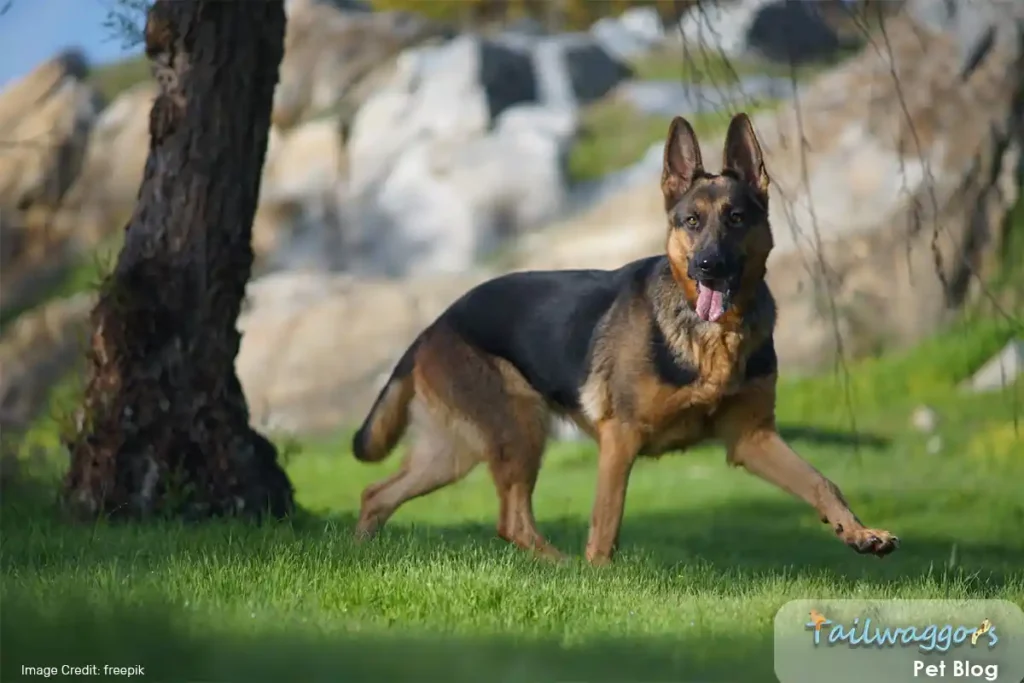
History and Origins of the German Shepherd
The German Shepherd Dog, celebrated for its intelligence, loyalty, and versatility, has a fascinating history rooted in precision and purpose. Originating in Germany during the late 19th century, this iconic breed was meticulously developed to serve as the ideal working dog—excelling in herding, guarding, and service roles. Over time, the German Shepherd’s exceptional traits have made it a global symbol of courage, adaptability, and unwavering devotion.
Quick Facts About German Shepherd Origins
| Aspect | Detail |
|---|---|
| Geographic Origin | Germany |
| Purpose | Herding sheep, guarding livestock, and assisting in versatile working roles |
| First Recognition | Recognized by the Verein für Deutsche Schäferhunde (SV) in 1899 |
| Introduction to the U.S. | Early 1900s; gained fame through Rin Tin Tin and service roles |
| Notable Contributions | Military and police service, search-and-rescue, and family companionship |
| Breed Development | Crossbred from herding dogs across Germany to standardize intelligence, strength, and versatility |
The Birth of a Purpose-Bred Working Dog
The German Shepherd’s origins trace back to the late 19th century, when Captain Max von Stephanitz, a German cavalry officer and dog enthusiast, envisioned a breed that epitomized strength, intelligence, and work ethic. At the time, herding dogs across Germany varied widely in appearance and abilities. Von Stephanitz sought to create a standardized breed that could excel in herding while being versatile enough for other working roles.
In 1899, von Stephanitz discovered Hektor Linksrhein, a dog whose physical structure, intelligence, and trainability embodied his ideal vision. Renamed Horand von Grafrath, this dog became the foundation of the German Shepherd breed. Through selective breeding, von Stephanitz and the Verein für Deutsche Schäferhunde (SV) honed the breed’s traits, emphasizing discipline, endurance, and adaptability.
Traits Bred for Excellence:
- Intelligence and Trainability: German Shepherds were designed to think independently and follow complex commands.
- Physical Strength and Endurance: Their muscular builds and strong frames enabled them to work tirelessly.
- Loyalty and Courage: Essential for guarding and protecting livestock, traits that transitioned seamlessly into service roles.
From Shepherd’s Fields to Worldwide Fame
Initially developed as herding dogs, German Shepherds quickly demonstrated their value in other fields. Their intelligence, strength, and discipline made them ideal candidates for military and police work. During World War I, German Shepherds served as messengers, guard dogs, and rescue animals, earning international admiration for their bravery and reliability.
The Journey to America: In the early 20th century, German Shepherds arrived in the United States, where they rose to prominence through film and service roles. Rin Tin Tin, a German Shepherd rescued from a World War I battlefield, became a Hollywood icon, showcasing the breed’s loyalty and intelligence on screen.
A Breed of Many Talents
German Shepherds’ adaptability has allowed them to excel in countless roles beyond herding:
- Military and Police Work: Their courage and obedience make them indispensable in law enforcement and defense.
- Search-and-Rescue Operations: With sharp senses and high stamina, German Shepherds thrive in disaster response missions.
- Service and Therapy Dogs: Their calm demeanor and intelligence make them exceptional companions for individuals with disabilities.
- Beloved Family Companions: While highly skilled in working roles, German Shepherds are also loving and protective members of the family.
Global Recognition and Enduring Popularity
In 1899, the German Shepherd was officially recognized by the Verein für Deutsche Schäferhunde (SV) in Germany. The American Kennel Club (AKC) recognized the breed in 1908, further cementing its reputation as one of the most intelligent and versatile dogs in the world. Today, German Shepherds remain a top choice for families, professionals, and organizations requiring dependable working dogs.
Why the German Shepherd Stands Out
From the herding fields of Germany to family homes worldwide, the German Shepherd’s journey is a testament to its versatility and dedication. Few breeds balance intelligence, loyalty, and courage as effortlessly, making the German Shepherd a symbol of excellence and companionship.
Before welcoming a German Shepherd into your home, consider these “10 Essential factors for bringing a new pet home”.

Personality Traits of the German Shepherd
German Shepherds are admired for their intelligence, loyalty, and adaptability, making them an excellent choice for families, professionals, and first-time dog owners. This remarkable breed embodies a protective nature paired with affection, excelling in both working roles and as cherished companions.
Table: German Shepherd Personality Profile
| Trait | Description |
|---|---|
| Intelligence | Ranked among the top 3 smartest breeds; excels in advanced training and problem-solving. |
| Energy Level | High energy; thrives with 1–2 hours of daily physical and mental stimulation. |
| Social Interaction | Deeply loyal to family but reserved with strangers; bonds strongly with loved ones. |
| Protectiveness | Naturally protective, making them exceptional family guardians. |
| Trainability | Highly trainable with consistent, structured, and positive reinforcement methods. |
| Compatibility with Kids | Excellent with children; gentle and patient when socialized early. |
| Compatibility with Pets | Sociable but benefits from gradual introductions to other animals. |
Loyal and Devoted Companions
German Shepherds are the epitome of loyalty, forming deep emotional connections with their families. Their protective instincts ensure they are always vigilant, safeguarding their loved ones with unwavering dedication.
Real-Life Example: Owners often share heartwarming stories of their German Shepherds’ devotion, such as waiting by the door until family members return or standing watch over sleeping children. Their loyalty is truly unparalleled.
Energetic and Purpose-Driven
With high energy levels and a need for purpose, German Shepherds thrive in active households that offer consistent physical and mental challenges. Activities like fetch, advanced training, or agility courses are vital for their happiness and well-being.
Exceptionally Intelligent and Trainable
Ranked among the most intelligent dog breeds, German Shepherds excel in obedience and problem-solving. Their eagerness to please makes them ideal for advanced training, working roles, and specialized tasks like search-and-rescue.
Pro Tip: Short, rewarding training sessions using treats, verbal praise, or interactive play yield the best results. Patience and consistency are key to unlocking their full potential.
Real-Life Example: German Shepherds often shine in service roles, such as assisting individuals with disabilities or performing search-and-rescue operations, showcasing their sharp minds and versatility
Protective and Watchful
As natural guardians, German Shepherds combine intelligence with a strong protective instinct. They are alert and quick to respond, making them trustworthy family protectors and watchdogs.
Key Insight: Early training and socialization are crucial to guiding their protective nature positively. Introducing them to various people and environments fosters confidence and composure.
Affectionate Yet Reserved
While German Shepherds are affectionate with their families, they may exhibit reserved behavior with strangers. This careful observation ensures they can assess situations thoughtfully, providing reliable companionship.
Real-Life Example: Many owners describe their German Shepherds as “gentle giants” who are loving with family but discerning and cautious when meeting new people or animals.
Why Choose a German Shepherd?
For families seeking a devoted companion, or professionals requiring a capable working partner, the German Shepherd excels in all roles. Their adaptability, intelligence, and protective nature ensure they remain one of the most versatile and beloved breeds worldwide.
German Shepherds are known for their intelligence and obedience. Learning “Essential Dog Training Commands” can further enhance their capabilities.
German Shepherds are deeply loyal but may struggle with being left alone for long periods, making “Understanding and Managing separation anxiety in dogs” essential.
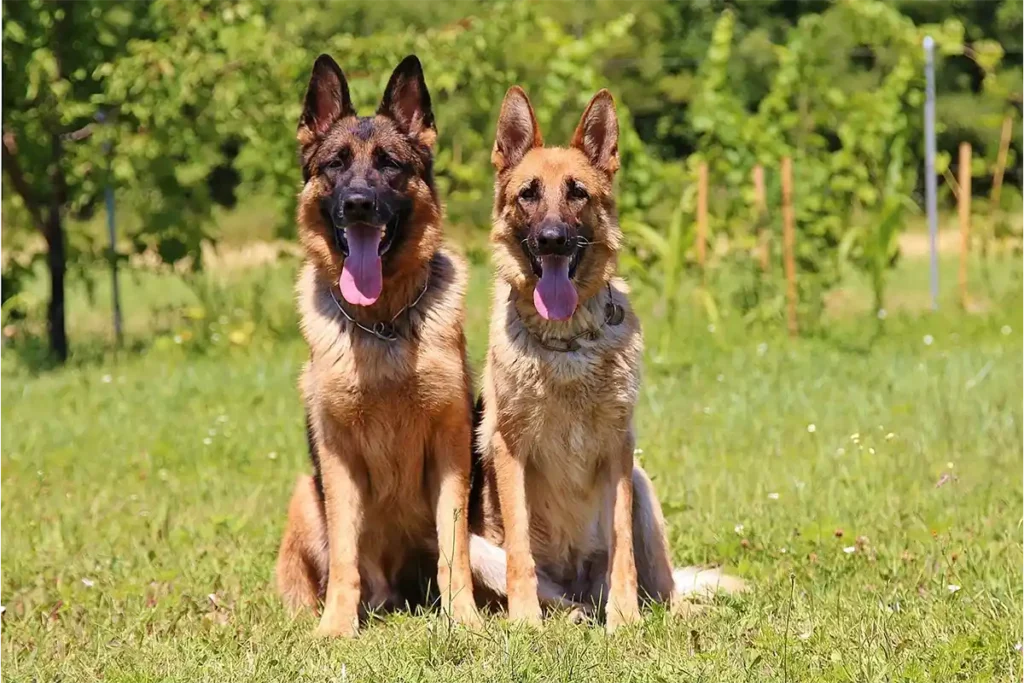
Physical Characteristics of the German Shepherd
The German Shepherd, with its distinctive silhouette, muscular build, and intelligent expression, is a breed that embodies strength, agility, and versatility. Originally bred for herding and working roles, every aspect of their physical form reflects their ability to perform demanding tasks with endurance and precision. These traits make German Shepherds equally suited to protecting, working, and thriving as loyal family members.
Size and Build
| Trait | Description |
|---|---|
| Average Height | Males: 24–26 in (61–66 cm); females: 22–24 in (55–61 cm) |
| Average Weight | Males: 65–90 lbs (29–41 kg); females: 50–70 lbs (23–32 kg) |
| Body Type | Muscular, balanced, and athletic; built for strength, endurance, and agility |
German Shepherds are medium to large-sized dogs with a harmonious build. Their deep chest, straight back, and powerful hindquarters equip them for tasks such as herding livestock, agility trials, and search-and-rescue missions. This combination of strength and agility enables them to perform at peak levels across diverse environments.
Notable Features
German Shepherds are instantly recognizable by their intelligent expressions and distinct physical traits:
- Eyes: Medium-sized, almond-shaped, and dark in color, exuding intelligence and focus.
- Ears: Large and erect, positioned high on their head, enhancing their alert and attentive demeanor.
- Muzzle: Long and strong, with a straight nasal bridge and powerful jaw, ideal for gripping objects.
- Tail: Long and bushy, carried low in a relaxed stance or raised when alert, reflecting their emotional state.
Their purposeful, smooth gait and balanced posture showcase the elegance and endurance required for their working roles.
Coat and Colors
| Trait | Description |
|---|---|
| Coat Type | Double coat: dense, weather-resistant outer layer with a soft insulating undercoat |
| Coat Texture | Straight and close-fitting; provides protection in various climates |
| Coloring | Common colors include black and tan, sable, all-black, or white |
The German Shepherd’s double coat is built for both function and durability. The outer coat shields them from harsh weather, while the soft undercoat provides insulation. This feature enables them to excel in diverse climates, from snowy mountains to sunny fields.
Pro Tip: Seasonal shedding is most intense in spring and fall, requiring owners to groom their German Shepherds more frequently during these periods.
Regular bathing, as explained in “How to bathe a dog”, keeps their coat clean and healthy.
Facial Features and Posture
| Feature | Description |
|---|---|
| Eyes | Almond-shaped, dark, and expressive of intelligence and loyalty |
| Ears | Upright and triangular, emphasizing their keen hearing and attentive nature |
| Tail | Bushy and low-hanging, reflecting their relaxed or alert state |
German Shepherds carry themselves with confidence and composure, whether they’re working or relaxing at home. Their balanced gait and poised demeanor are hallmarks of their herding and guarding heritage.
Key Physical Traits of the German Shepherd
- Athletic Build: Strong, agile, and muscular, making them ideal for demanding tasks such as herding and agility training.
- Distinctive Double Coat: Durable and weather-resistant, requiring consistent grooming to maintain its health and shine.
- Expressive Features: Intelligent eyes, upright ears, and a poised tail reflect their alert and adaptable nature.
- Graceful Movement: A smooth gait designed for endurance and efficiency.
Why Understanding These Characteristics Matters
Knowing the physical traits of German Shepherds helps owners meet their grooming, exercise, and care needs. Their muscular build and double coat reflect their history as versatile working dogs, emphasizing the importance of proper grooming and fitness.
Why the German Shepherd Stands Out
The German Shepherd’s physical characteristics combine beauty, functionality, and endurance. Their iconic silhouette, expressive features, and powerful build make them one of the most recognizable breeds in the world. Whether excelling in demanding work or enjoying family life, their versatility and grace ensure they remain a standout breed.
Did you know that some German Shepherd love sticking out their tongues? Find out other reasons why in this vet-reviewed guide.
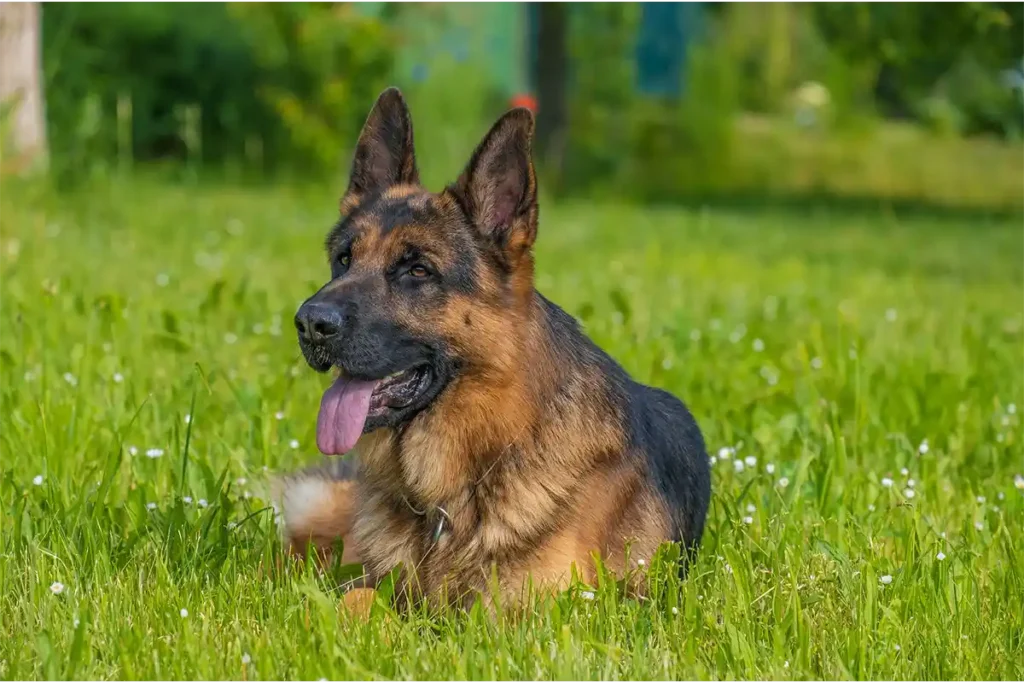
Health and Lifespan of the German Shepherd
German Shepherds are celebrated for their loyalty, intelligence, and versatility, but they require dedicated care to manage specific health challenges. With an average lifespan of 9 to 13 years, these devoted companions can thrive with proactive health management, balanced nutrition, and regular veterinary care. By addressing their unique needs, owners can help German Shepherds live vibrant, healthy lives.
Average Lifespan of German Shepherd
The average lifespan of a German Shepherd ranges from 9 to 13 years, influenced by genetics, diet, exercise, and preventative care. While they are resilient, their predisposition to certain health conditions highlights the importance of regular checkups and early intervention.
Common Health Issues in German Shepherd
Understanding the health challenges specific to German Shepherds empowers owners to take preventive actions and seek timely care.
| Condition | Description |
|---|---|
| Hip Dysplasia | Improper hip joint development, leading to arthritis and mobility issues. |
| Elbow Dysplasia | Abnormal elbow joint formation, causing discomfort and reduced mobility. |
| Degenerative Myelopathy | A progressive spinal cord condition affecting coordination and mobility. |
| Bloat (GDV) | A life-threatening stomach condition requiring immediate veterinary attention. |
| Exocrine Pancreatic Insufficiency (EPI) | A digestive disorder resulting in poor nutrient absorption and weight loss. |
| Heart Disease | Conditions like dilated cardiomyopathy (DCM) can impact heart function. |
| Skin Allergies | Environmental or dietary triggers causing itchiness and discomfort. |
Preventive Care and Regular Vet Checkups
Proactive care is the cornerstone of a long, healthy life for German Shepherds. Regular veterinary visits, visits, proper grooming, and an active lifestyle can prevent many common health issues.
| Health Aspect | Recommended Action | Frequency |
|---|---|---|
| Hip and Joint Health | Monitor for stiffness or limping; use vet-approved joint supplements. | Annually or as needed |
| Weight Management | Feed a balanced diet and ensure regular exercise. | Monthly monitoring |
| Bloat Prevention | Feed smaller meals; avoid vigorous activity after eating. | Daily |
| Digestive Health | Monitor for symptoms of EPI, such as weight loss or diarrhea. | As needed |
| Dental Care | Brush teeth and offer dental chews to prevent plaque buildup. | Weekly; professional cleaning annually |
| Heart Health | Conduct routine screenings for heart disease. | Annually |
| Skin Health | Use medicated shampoos and consult a vet for persistent allergies. | As needed |
Some owners explore options like “CBD oil for dogs” to manage joint discomfort.
Signs of Illness to Watch For in German Shepherd
Timely intervention is crucial for managing health concerns. Watch for these signs and consult a veterinarian promptly:
- Mobility Issues: Limping, stiffness, or difficulty rising may indicate hip or elbow dysplasia.
- Digestive Problems: Chronic diarrhea or weight loss may signal EPI or gastrointestinal disorders.
- Swollen Abdomen: Bloat (GDV) requires immediate veterinary attention.
- Lethargy or Fatigue: A reduction in energy levels may indicate heart disease or metabolic issues.
- Scratching or Red Skin: Persistent itching could point to allergies or skin infections.
- Coordination Loss: Difficulty walking or dragging hind legs may signal degenerative myelopathy.
German Shepherds may face certain health challenges. Recognizing “11 Warning signs you should take your dog to the vet” can help catch conditions early.
Ensuring a Healthy Life for Your German Shepherd
Proactive care is the best way to ensure your German Shepherd remains active and healthy throughout their life. Their energetic and intelligent nature thrives with consistent physical activity, mental stimulation, and attentive healthcare.
Key Areas of Care:
- Balanced Nutrition: Provide high-quality, breed-specific food tailored to your German Shepherd’s age and activity level.
- Regular Exercise: Aim for 1–2 hours of activity daily, including walks, runs, and training exercises.
- Routine Grooming: Brush their coat 2–3 times a week and bathe as needed to maintain skin health.
- Annual Screenings: Schedule checkups to monitor joint health, heart function, and signs of degenerative conditions.
Why Health Awareness Matters
German Shepherds are loyal and intelligent companions whose health needs deserve attentive care. By prioritizing preventative measures, routine screenings, and a healthy lifestyle, you can ensure your German Shepherd thrives for years to come.

Caring for an German Shepherd: Grooming, Diet and Enrichment Tips
German Shepherds, with their intelligent minds and high energy, thrive when their physical, mental, and emotional needs are met. From their weather-resistant double coats to their active nature, proper care is essential for ensuring they lead happy, healthy, and fulfilling lives.
Table: Care Requirements for German Shepherd
| Care Aspect | Requirement Level | Frequency | Details | Importance Rating |
|---|---|---|---|---|
| Grooming | High | 2–3 times weekly | Brushing, bathing, and nail trimming to manage shedding and maintain coat health. | ⭐⭐⭐⭐⭐ |
| Feeding | High | Daily | Balanced meals with high-quality protein and controlled portions. | ⭐⭐⭐⭐⭐ |
| Exercise | Very High | Daily | 1–2 hours of physical activity, including walking, running, or agility training. | ⭐⭐⭐⭐⭐ |
| Mental Stimulation | Very High | Continuous | Training, puzzle toys, and scent games to engage their sharp minds. | ⭐⭐⭐⭐⭐ |
| Environment | High | Continuous | A secure outdoor area and cozy indoor spaces for rest and relaxation. | ⭐⭐⭐⭐ |
Grooming: Caring for Their Distinctive Double Coat
German Shepherds’ dense double coats shed year-round and require regular care to manage shedding and maintain skin health. Grooming also strengthens the bond between you and your dog.
Key Grooming Practices:
- Brushing: Use an undercoat rake or slicker brush 2–3 times a week to prevent matting, reduce shedding, and distribute natural oils.
- Bathing: Bathe every 6–8 weeks with a gentle, dog-safe shampoo to avoid stripping the coat’s protective oils. Read more on “How to bathe your dog stress-free“
- Ear Care: Clean ears weekly with a vet-recommended solution to prevent infections caused by trapped moisture.
- Nail Trimming: Trim nails every 2–3 weeks to prevent overgrowth and discomfort during movement.
- Dental Hygiene: Brush teeth 2–3 times a week and provide dental chews to reduce plaque and support oral health.
Diet and Nutrition: Fueling Their Energy and Vitality
German Shepherds’ high activity levels require a nutritionally balanced diet to support their energy needs, maintain their weight, and promote overall health.
Key Nutritional Needs:
- High-Quality Protein: Real meat or fish as the first ingredient supports lean muscle mass.
- Healthy Fats: Include Omega-3 and Omega-6 fatty acids for joint health and a glossy coat.
- Portion Control: Overfeeding can lead to obesity, increasing the risk of joint and heart issues.
Feeding Schedule:
- Adults: Serve two balanced meals daily, with portion sizes based on age, weight, and activity level.
- Puppies: Feed 3–4 smaller meals per day to support their growth and energy needs.
Exercise: Meeting Their High Energy Needs
German Shepherds are active dogs that require regular physical activity to prevent boredom and maintain optimal health.
Physical Activity Recommendations:
- Daily Exercise: Provide 1–2 hours of physical activity, including walks, runs, or swimming.
- Low-Impact Activities: Swimming is excellent for joint health and ideal for large breeds prone to hip dysplasia.
- Agility and Sports: Enroll in agility or obedience training to challenge their physical and mental capabilities.
Mental Stimulation Ideas:
- Puzzle Toys: Encourage problem-solving and reward curiosity.
- Interactive Play: Games like fetch or hide-and-seek engage their natural instincts.
- Training Sessions: Use positive reinforcement to teach commands, tricks, or scent-tracking tasks.
Interactive toys and training sessions are just some of the “9 Simple ways to make your dogs happy”.
Creating a Comfortable Environment
German Shepherds need a secure, stimulating environment to thrive. Whether indoors or outdoors, their living spaces should cater to their active and social nature.
- Indoors: Provide a cozy resting area with soft bedding for relaxation after playtime.
- Outdoors: Ensure a secure backyard with enrichment options like obstacle courses or digging boxes.
- Temperature Awareness:
- Hot Weather: Provide shade, fresh water, and limit outdoor activity during peak heat.
- Cold Weather: Their coats provide natural insulation, but ensure access to a warm, dry space during extreme cold.
Why Proper Care Matters
German Shepherds are loyal, intelligent companions who thrive with attentive care. By prioritizing their grooming, nutrition, exercise, and mental enrichment, you’ll ensure your dog remains happy, healthy, and fulfilled.
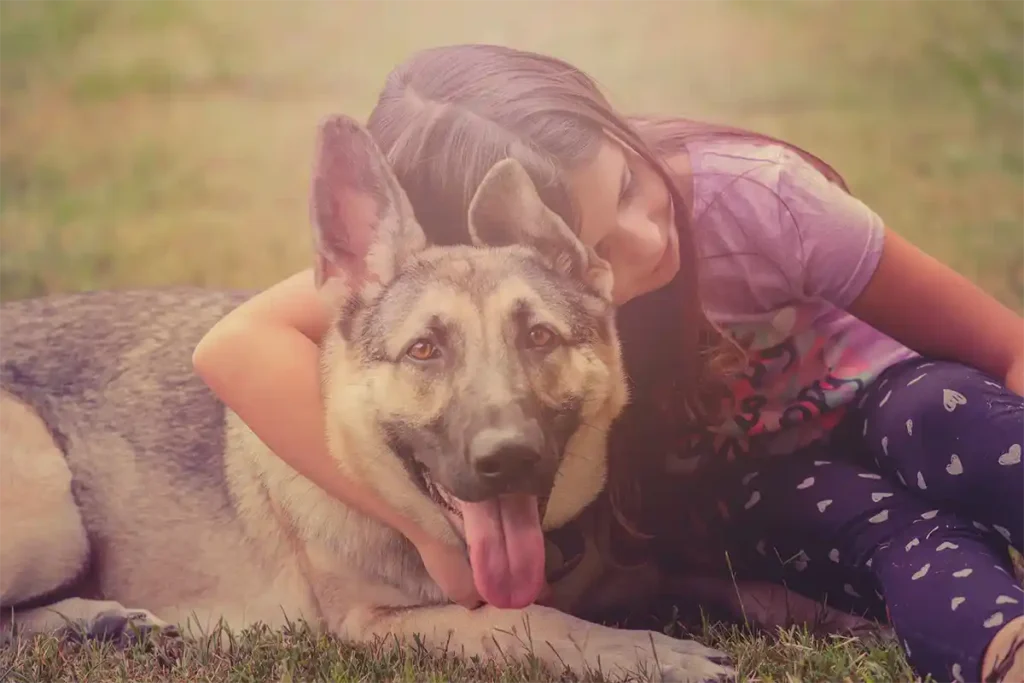
Owning an German Shepherd: Budgeting and Financial Insights
Bringing a German Shepherd into your family is an exciting and rewarding decision, but it’s essential to understand the financial commitment that comes with owning this intelligent and versatile breed. From initial setup costs to ongoing care expenses, planning ahead ensures your German Shepherd receives the care and attention they deserve throughout their life.
Table: Cost Breakdown Analysis for German Shepherd
| Expense Category | Initial Cost (USD) | Annual Cost (USD) | Value Rating |
|---|---|---|---|
| Adoption or Breeder Fees | $150–$3,500 | N/A | ⭐⭐⭐⭐⭐ |
| Food and Treats | N/A | $620–$1,240 | ⭐⭐⭐⭐⭐ |
| Grooming | $50–$100 | $350–$800 | ⭐⭐⭐⭐ |
| Veterinary Care | $200–$600 | $550–$1,200 | ⭐⭐⭐⭐⭐ |
| Pet Insurance | N/A | $300–$900 | ⭐⭐⭐⭐ |
| Toys and Enrichment | $50–$100 | $100–$300 | ⭐⭐⭐⭐ |
| Training Classes | $100–$500 | Optional | ⭐⭐⭐⭐⭐ |
| Emergency Care | $200–$5,000+ | N/A | ⭐⭐⭐⭐ |
Initial Costs: Preparing for Your German Shepherd
Adoption vs. Breeder Fees
- Adoption Fees ($150–$300): Choosing a rescue or shelter is a cost-effective option, often including vaccinations, microchipping, and spaying/neutering.
- Breeder Fees ($800–$3,500): Purchasing from a reputable breeder ensures health-tested puppies with documented lineage, but this comes at a premium.
Essential Supplies for Day One
Prepare your home with the following essentials to ensure a smooth transition for your German Shepherd:
| Item | Cost Range (USD) |
|---|---|
| Dog Crate | $50–$150 |
| Food and Water Bowls | $20–$50 |
| Leash and Collar | $30–$60 |
| Bed | $40–$100 |
| Toys | $20–$50 |
| Grooming Supplies | $50–$100 |
| Training Tools | $20–$40 |
Estimated Setup Cost: $200–$500
🐾 Tailwaggors Tip:
Invest in durable supplies like chew-proof leashes, heavy-duty crates, and long-lasting toys. These may cost more upfront but save money in the long run
Ongoing Annual Costs
Food and Treats
German Shepherds are active, muscular dogs requiring a high-quality, nutritious diet to maintain their health and energy.
| Expense | Annual Cost Range (USD) |
|---|---|
| Dry Food | $500–$1,000 |
| Treats | $120–$240 |
Total Annual Food Cost: $620–$1,240
🐾 Tailwaggors Tip:
Enhance your German Shepherd’s meals with vet-approved toppers like cooked salmon or plain yogurt for added flavor and nutrients. Always avoid harmful foods like chocolate, onions, and grapes.
Veterinary Care
Preventive veterinary care is crucial for keeping your German Shepherd healthy and avoiding costly emergencies.
| Service | Annual Cost Range (USD) |
|---|---|
| Wellness Exams | $100–$300 |
| Vaccinations | $50–$100 |
| Flea, Tick, and Worm Prevention | $100–$200 |
| Dental Cleaning | $300–$600 (as needed) |
| Emergency Fund | $200–$5,000+ (recommended) |
Total Annual Veterinary Cost: $550–$1,200+
🩺 Veterinary Insight:
“German Shepherds are prone to conditions like hip dysplasia, digestive disorders, and allergies. Regular checkups and preventive care help catch issues early and reduce long-term costs,” advises Dr. Esther Knoetze, BSc, BVSc
Grooming
Their double coat requires regular upkeep to manage shedding and maintain skin health.
| Type | Annual Cost Range (USD) |
|---|---|
| Professional Grooming | $300–$700 |
| At-Home Grooming Supplies | $50–$100 |
🐾 Tailwaggors Tip:
Brush your German Shepherd 2–3 times a week using an undercoat rake to reduce shedding and cut down on professional grooming visits.
Training and Enrichment
Proper training and enrichment activities are essential for a well-rounded German Shepherd.
| Expense | Annual Cost Range (USD) |
|---|---|
| Training Classes | $100–$500 (initially) |
| Toys and Enrichment | $100–$300 |
Total Annual Training and Enrichment Cost: $200–$800
Hidden and Emergency Costs
- Emergency Veterinary Care: $200–$5,000+ for unexpected surgeries or critical care.
- Pet Insurance: Monthly premiums typically range from $25 to $75.
- Pet Boarding or Sitting: $25–$50 per day during travel.
🐾 Tailwaggors Tip:
Consider pet insurance to cover unexpected medical expenses. While the annual cost may range from $300 to $900, it provides peace of mind in emergencies
Unexpected costs can arise. Prepare with this “Comprehensive Emergency guide for dog owners”.
Cost-Saving Strategies for German Shepherd Owners
- Buy in Bulk: Save on food and supplies by purchasing larger quantities during sales.
- Preventive Healthcare: Regular vet visits help catch minor health issues before they become costly problems.
- DIY Grooming: Learn to brush, trim nails, and clean ears at home to minimize professional grooming costs.
- Invest in Quality Supplies: Durable toys, beds, and collars last longer and reduce replacement expenses.
Is Owning a German Shepherd Worth the Investment?
German Shepherds are intelligent, loyal companions who enrich their families’ lives. While they require financial planning, the love, protection, and joy they bring make them worth every penny. By budgeting for their needs and providing consistent care, you’ll ensure your German Shepherd thrives as a cherished member of your household.
Understanding “10 things to consider before bringing a new pet home” can help prepare for the costs of owning a German Shepherd.
🐾 Tailwaggors Tip:
Owning a German Shepherd is more than a financial commitment—it’s a lifelong investment in a loyal, intelligent, and loving family member. Plan ahead, embrace the journey, and your dog will reward you with endless love and companionship
🩺 Veterinary Insight:
“German Shepherds require structured care and financial preparedness to address their unique health and activity needs. Pet parents who budget for food, grooming, and preventive care set their dogs up for a lifetime of health and happiness,” says Dr. Esther Knoetze, BSc, BVSc
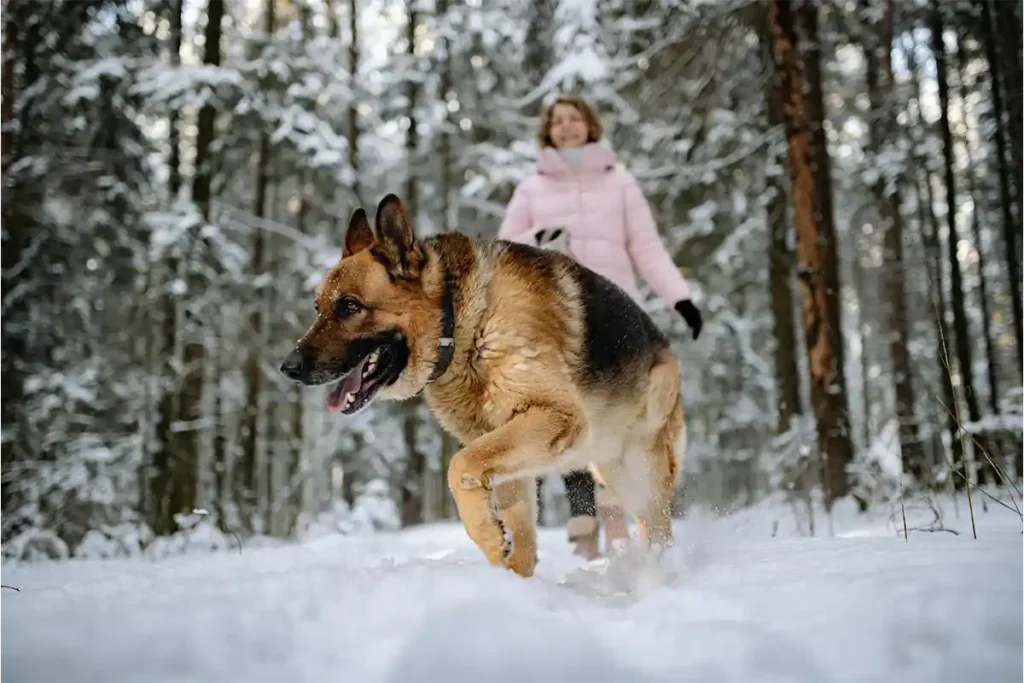
Breed Comparison: German Shepherd vs. Other Popular Breeds
Choosing the right breed involves evaluating key factors like size, temperament, energy levels, and care needs. German Shepherds, celebrated for their intelligence, loyalty, and adaptability, are often compared to breeds like Belgian Malinois, Rottweilers, and Golden Retrievers. Let’s explore how the German Shepherd stacks up against these popular breeds to help you decide which fits your lifestyle best.
Table: How Does the German Shepherd Compare?
| Aspect | German Shepherd | Belgian Malinois | Rottweiler | Golden Retriever |
|---|---|---|---|---|
| Size | Large (50–90 lbs / 23–41 kg) | Large (40–80 lbs / 18–36 kg) | Large (80–135 lbs / 36–61 kg) | Large (55–75 lbs / 25–34 kg) |
| Coat | Double coat, weather-resistant | Short coat, weather-resistant | Short coat, dense and glossy | Dense, water-resistant double coat |
| Personality | Loyal, protective, intelligent | High-energy, intense, loyal | Confident, calm, protective | Friendly, affectionate, outgoing |
| Grooming Needs | Moderate (regular brushing) | Low (minimal brushing) | Low (occasional brushing) | Moderate (regular brushing) |
| Energy Level | High; thrives on structured activities | Very high; needs intense engagement | Moderate; requires daily exercise | High; thrives on activity and play |
| Trainability | Highly trainable, eager to work | Extremely trainable, thrives on tasks | Highly trainable but can be independent | Highly trainable, eager to please |
| Compatibility with Pets | Generally good with socialization | Good but needs supervision | Variable; may not tolerate other pets | Excellent; friendly with other pets |
German Shepherd vs. Belgian Malinois
German Shepherds and Belgian Malinois share intelligence and strong work ethics, but they differ in energy levels and temperament.
- Energy Levels: Malinois are exceptionally high-energy, requiring intense engagement, while German Shepherds offer a balanced energy suited to family life.
- Grooming: German Shepherds need regular brushing to manage shedding, while Malinois require minimal coat maintenance.
- Personality: Malinois are highly focused and thrive in working roles, making them ideal for experienced owners. German Shepherds balance loyalty with adaptability, fitting into diverse households.
🐾 Tailwaggors Tip:
If you’re an experienced dog owner looking for a high-energy working partner, the Belgian Malinois may be your match. For families or individuals seeking a protective yet adaptable companion, the German Shepherd is the better fit.
German Shepherd vs. Rottweiler
Both breeds are confident and protective, but they differ in temperament and size.
- Size: Rottweilers are significantly larger, often weighing up to 135 lbs, which requires careful space and weight management.
- Energy Levels: German Shepherds are more active and thrive on structured exercise, while Rottweilers enjoy moderate activity.
- Personality: Rottweilers are calm and confident, while German Shepherds are outgoing and eager to interact with their families.
🐾 Tailwaggors Tip:
If you prefer a calm, protective companion, the Rottweiler may suit your needs. For a more active, versatile breed that excels in both working and family roles, the German Shepherd stands out.
German Shepherd vs. Golden Retriever
German Shepherds and Golden Retrievers are both intelligent and family-friendly, but their temperaments and grooming needs vary.
- Coat and Grooming: German Shepherds’ double coats shed heavily and need regular brushing. Golden Retrievers require similar maintenance for their water-resistant coats.
- Temperament: Goldens are gentle and sociable, while German Shepherds are protective and make excellent guard dogs.
- Energy Levels: Both breeds are active, but German Shepherds excel in structured training, while Goldens thrive in playful family settings.
🐾 Tailwaggors Tip:
For families wanting a playful, easygoing companion, the Golden Retriever is a fantastic choice. If you need a loyal, protective dog with exceptional trainability, the German Shepherd is unmatched.
Read the Labrador Retriever: Ultimate Breed Guide for more details on this playful breed.
Why Choose the German Shepherd?
The German Shepherd’s intelligence, loyalty, and versatility make it one of the most sought-after breeds worldwide. Whether serving as a working dog, family protector, or devoted companion, the German Shepherd excels in every role. Their trainability and balanced energy make them ideal for active households and professional environments.
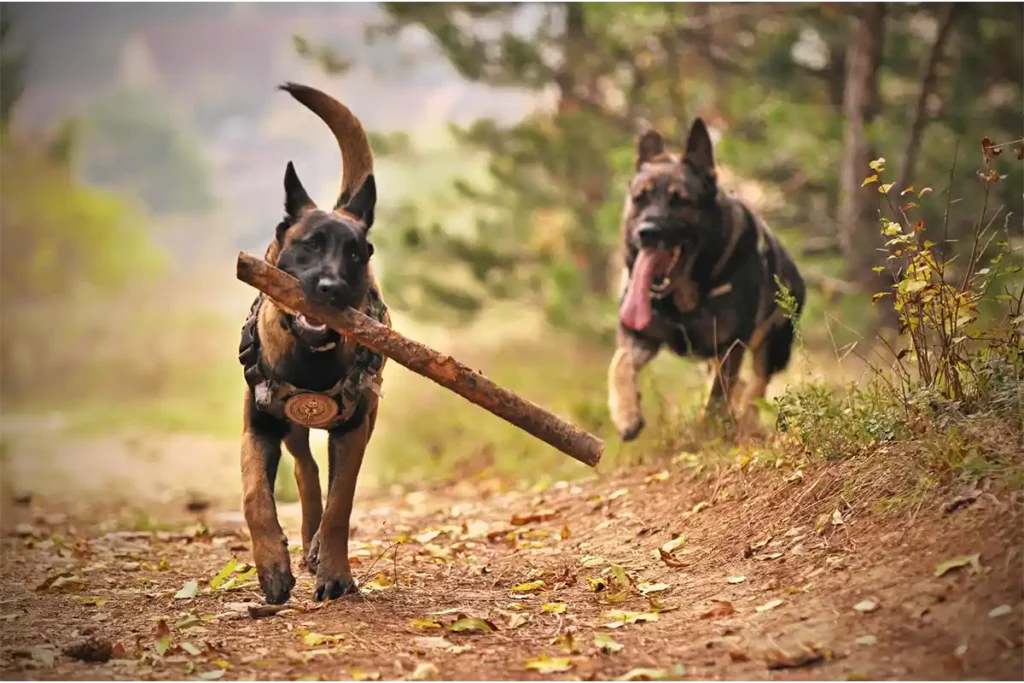
Frequently Asked Questions About the German Shepherd
German Shepherds are renowned for their intelligence, loyalty, and versatility. Whether you’re considering adding one to your family or already share your life with a German Shepherd, these FAQs answer common questions about caring for this remarkable breed.
1. Are German Shepherds hypoallergenic?
+No, German Shepherds are not hypoallergenic. Their double coats shed year-round, with heavier shedding during seasonal changes. Fur and dander can cause allergies in sensitive individuals.
🐾 Tailwaggors Tip:
Brush your German Shepherd 2–3 times weekly with an undercoat rake and bathe them every 6–8 weeks. A HEPA air filter can also help reduce allergens in your home.
2. How much do German Shepherds weigh?
+German Shepherds are large dogs with a strong, muscular build:
- Males: 65–90 lbs (29–41 kg)
- Females: 50–70 lbs (23–32 kg)
Their weight is proportional to their active, working-dog heritage, making them ideal for physically engaged families.
3. How long do German Shepherds live?
+German Shepherds have an average lifespan of 9–13 years. Proper nutrition, regular exercise, and preventive care can help maximize their life expectancy.
🩺 Veterinary Insight:
“Routine screenings for joint health and early intervention in conditions like degenerative myelopathy can significantly improve the quality of life for German Shepherds,” says Dr. Esther Knoetze, BSc, BVSc.
4. Are German Shepherds good with children?
+Yes, German Shepherds are protective and patient, making them wonderful companions for kids. With proper training and socialization, they adapt well to family life.
🐾 Tailwaggors Tip:
Always supervise interactions between young children and dogs to ensure safe and positive experiences.
5. Do German Shepherds bark a lot?
+German Shepherds are moderate barkers. They will alert their owners to strangers, unusual noises, or excitement, but excessive barking can be managed with training.
6. How much exercise do German Shepherds need?
+German Shepherds require at least 1–2 hours of structured physical and mental activity daily. Activities like hiking, agility training, and scent-tracking games are excellent for keeping them engaged.
🐾 Tailwaggors Tip:
Combine physical exercise with mental stimulation, such as puzzle toys or obedience training, to prevent boredom and destructive behaviors.
7. Are German Shepherds easy to train?
+Yes, German Shepherds are highly intelligent and eager to please. They thrive with consistent, reward-based training methods.
🐾 Tailwaggors Tip:
Start training your German Shepherd early with short, engaging sessions. Using treats and praise ensures they stay motivated and focused.
8. What are the grooming needs of a German Shepherd?
+Their dense double coats require regular maintenance:
- Brushing: 2–3 times weekly to reduce shedding
- Bathing: Every 6–8 weeks or as needed
- Professional Grooming: Occasionally for trimming and coat care
🩺 Veterinary Insight:
“Regular grooming is crucial for managing shedding and identifying skin issues or ticks early,” advises Dr. Esther Knoetze, BSc, BVSc.
9. Are German Shepherds prone to health issues?
+Yes, they are predisposed to certain conditions, including:
- Hip and Elbow Dysplasia: Joint conditions that can lead to arthritis
- Degenerative Myelopathy: A progressive spinal cord condition affecting mobility
- Allergies: Often related to environmental or dietary triggers
Routine veterinary care and early health screenings help manage these issues effectively.
10. Can German Shepherds live in apartments?
+Yes, with sufficient exercise and mental stimulation, German Shepherds can adapt to apartment living. Without these, they may become bored and exhibit destructive behaviors.
🐾 Tailwaggors Tip:
Daily walks, interactive toys, and training sessions are essential for keeping your German Shepherd content in smaller living spaces.
Why These FAQs Matter
German Shepherds are loyal, intelligent companions that thrive when their needs are met. By addressing common questions about their care, grooming, and health, you’ll be better prepared to provide a fulfilling life for your German Shepherd.
Are German Shepherd safe around plants? Learn which plants to avoid with this vet-approved guide on toxic plants for dogs. Be prepared for emergencies by learning first aid for pets.
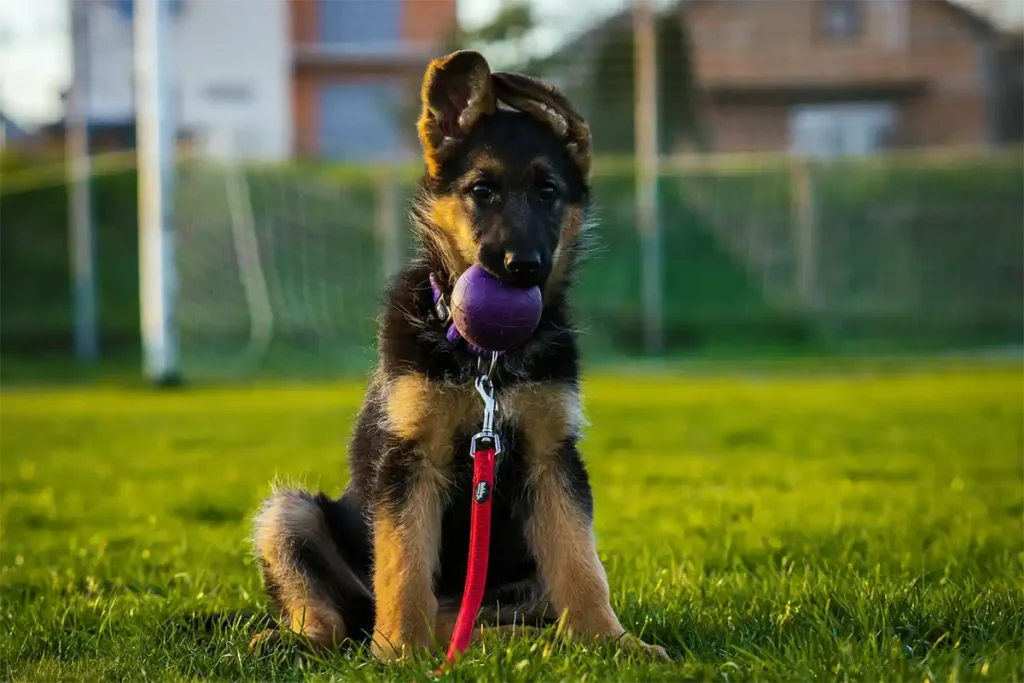
Conclusion: Wrapping Up the Ultimate Guide to the German Shepherd
The German Shepherd embodies the perfect balance of intelligence, loyalty, and versatility. Whether serving as a working dog, family protector, or devoted companion, this remarkable breed excels in every role, leaving an indelible mark on the lives of those who know them.
Their high trainability, protective instincts, and deep bond with their families make German Shepherds one of the world’s most admired breeds. For active individuals, experienced dog owners, or families seeking a loyal and intelligent companion, the German Shepherd is an unparalleled choice.
Explore 7 proven strategies to strengthen your connection with your pet for a lifelong bond.
Providing the Best Care for Your German Shepherd
To ensure your German Shepherd thrives and lives a fulfilling life, focus on these essential care practices:
- Grooming: Brush 2–3 times weekly to manage shedding and maintain their coat’s health.
- Nutrition: Provide a high-quality, protein-rich diet tailored to their size and energy level.
- Exercise and Enrichment: Offer at least 1–2 hours of structured physical activity combined with mental stimulation, such as training, scent work, or puzzle toys.
- Veterinary Care: Schedule regular wellness visits, preventative screenings, and early interventions for breed-specific concerns like hip dysplasia and degenerative myelopathy.
Is the German Shepherd Right for You?
Welcoming a German Shepherd into your family is a deeply rewarding experience that comes with important responsibilities. These intelligent, high-energy dogs are best suited for individuals and families who:
- Enjoy outdoor activities like hiking, running, or agility training.
- Are committed to grooming, training, and regular exercise routines.
- Seek a loyal, protective, and highly trainable companion who thrives on interaction and purpose.
If you’re ready to embrace the joy of owning a German Shepherd, you’ll gain more than just a pet—you’ll welcome a devoted family member who brings years of loyalty, protection, and companionship.
Read more on 10 things to concider before bringing a new pet home.

Share Your German Shepherd Story!
We’d love to hear about your German Shepherd adventures! Share your favorite moments, tips, and insights in the comments below. Join our community on social media for expert advice, inspiring stories, and updates on German Shepherds and other incredible breeds. Contact Tailwaggors.
Meet the German Shepherd—a loyal, intelligent, and versatile companion!
🐾✨ Dive into this ultimate guide to uncover their personality, care tips, and why they’re among the world’s most beloved breeds.
Share with fellow dog lovers and celebrate the unmatched brilliance of the German Shepherd! 🐶❤️


